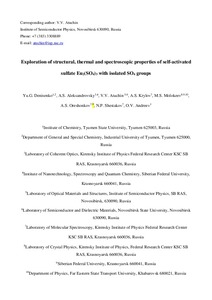Exploration of structural, thermal and spectroscopic properties of self-activated sulfate Eu2(SO4)3 with isolated SO4 groups
Скачать файл:
URI (для ссылок/цитирований):
https://www.sciencedirect.com/science/article/pii/S1226086X18304180https://elib.sfu-kras.ru/handle/2311/111428
Автор:
Denisenko, Yu. G.
Aleksandrovsky, A. S.
Atuchin, V. V.
Krylov, A. S.
Molokeev, M. S.
Oreshonkov, A. S.
Shestakov, N. P.
Andreev, O. V.
Коллективный автор:
Инженерно-строительный институт
Институт инженерной физики и радиоэлектроники
Кафедра проектирования зданий и экспертизы недвижимости
Базовая кафедра физики твердого тела и нанотехнологий
Институт нанотехнологий, спектроскопии и квантовой химии
Дата:
2018-08Журнал:
Journal of Industrial and Engineering ChemistryКвартиль журнала в Scopus:
Q1Квартиль журнала в Web of Science:
Q1Библиографическое описание:
Denisenko, Yu. G. Exploration of structural, thermal and spectroscopic properties of self-activated sulfate Eu2(SO4)3 with isolated SO4 groups [Текст] / Yu. G. Denisenko, A. S. Aleksandrovsky, V. V. Atuchin, A. S. Krylov, M. S. Molokeev, A. S. Oreshonkov, N. P. Shestakov, O. V. Andreev // Journal of Industrial and Engineering Chemistry. — 2018.Аннотация:
Eu2(SO4)3 was synthesized by chemical precipitation method and the crystal structure was determined by Rietveld analysis. The compound crystallizes in monoclinic space group С2/с. In the air environment, Eu2(SO4)3 is stable up to 670°C. The sample of Eu2(SO4)3 was examined by Raman, Fourier-transform infrared absorption and luminescence spectroscopy methods. The low site symmetry of SO4 tetrahedra results in the appearance of the IR inactive ν1 mode around 1000 cm–1 and ν2 modes below 500 cm–1. The band intensities redistribution in the luminescent spectra of Eu3+ ions is analyzed in terms of the peculiarities of its local environment.

